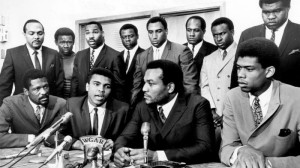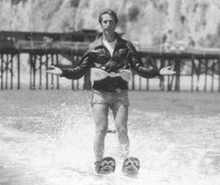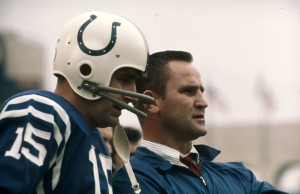NFL Network’s A Football Life Has Jumped the Shark
In case you are not familiar with the term “Jumping the Shark”, it refers to the great 1970s TV Show Happy Days. Towards the end of its run on ABC, they had an episode when “The Fonz” somehow ended up on water skis and actually jumped a shark (or at least a mechanical shark). To fans, it signaled the moment when they knew the show was out of realistic plots and was on its way towards the end.
Given that the first three episodes of season eight of A Football Life have included a pair of shows about quarterbacks with a combined total of one conference championship appearance during their careers, I think it is clear that this once great show has passed its “Jump the Shark” moment.
When A Football Life first came on the air in 2011, it provided a fresh and innovative approach for telling about the football journeys for some of the great figures in recent NFL history. Most of those highlighted were living at the time they were featured, though that has not always been the case.
After starting with a two-part episode about New England Coach Bill Belichick, they followed up with a fresh look at a pair of former teammates whose lives ended early, Reggie White & Jerome Brown. Other tales from the opening season focused on the cinema worthy stories of Kurt Warner, Walter Payton, Ed Sabol, Mike Ditka, Tom Landry and Al Davis.
Though the second season began with a nod to the “flavor of the moment” by featuring Tim Tebow, the remainder of the season was excellent with every episode telling a unique, behind the curtain, story about an NFL Legend.
As a fan of NFL history, if there has been anything significant to criticize about the choices of former players to feature, it would be that they have almost totally ignored players from the pre-Super Bowl era and in reality, have focused disproportionately on players from the 1980s to today.
Not counting shows on former players who became coaches or broadcasters, through the first seven seasons there have only been four shows featuring players whose primary years in the league occurred prior to 1970 (Jim Brown, Joe Namath, the Los Angeles Rams Fearsome Foursome and Chicago Bears greats Gale Sayers and Dick Butkus).
To me that is really a shame. I understand maybe not going back to the beginning of NFL history to feature former greats who have been gone for generations, but given that NFL Films originated in the 1960s, I cannot understand why they have basically ignored that great era of the NFL and AFL.
Off the top of my head, I can name 10-20 players who were active in the 1960s and either are still alive or were alive when the series started that would be great to feature. Players like Bart Starr and Willie Davis from the great Packer teams, the first Dallas Cowboy draft pick Bob Lilly, Sam Huff, Alex Karras, Y.A. Tittle, Sonny Jurgensen, Len Dawson, John Brodie, Lenny Moore, Hugh McElhenny, Fran Tarkenton and the recently deceased Tommy McDonald are just a few of the many players from that era that had amazing NFL journeys and would have been great to feature in the series.
Though the bias to the post-merger era has always been there, in the early years there was at least a balance with some shows featuring players from the 1970s and early 1980s.
However, in recent years, the show seems to have become more of a vehicle for current broadcasters and recently inducted Hall of Famers.
The current season is especially focused in that area. Of the 11 episodes this year (down from 13 in each of the previous three seasons and a high of 22 in season three), three are on current TV personalities Willie McGinest, Tony Romo and Cris Collingsworth and a fourth is on recent Hall of Famer Brian Dawkins. Another is on recently retired quarterback Carson Palmer. Only two of the players featured, Doug Williams (drafted in 1978) and Dwight Clark (1979) spent any of their career in the 1970s.
While McGinest, Romo and Collingsworth were all solid NFL players and are familiar to TV audiences, none of them are ever going to be in the Hall of Fame and in my opinion compared to the players I mentioned earlier and many others, the “Football Life” of those guys really doesn’t have a lot of interest to me.
When thinking about which NFL greats have yet to be featured, there are a few from the post-merger era who especially come to mind as surprising that they have yet to be included.
The two most obvious exclusions are former Super Bowl quarterbacks Joe Montana and John Elway. It makes me wonder if they have declined to be included. Two others who I am surprised have never been featured are Bo Jackson and Herschel Walker.
Excluding those players, below are 5 players who primarily played after 1960 that I think would be great candidates for the show. Three of these five players are still alive, while two have passed away in recent years.
Earl Morrall – In a career that started in 1956 and ended in 1976, Morrall was never really a leading man, but he seemed to be part of the supporting cast for many huge moments in NFL history. He was a first round pick (second overall) by the San Francisco 49ers in 1956 when the 49ers had the famous “Million Dollar Backfield”. He was traded the next season to the Pittsburgh Steelers and actually made the Pro Bowl in 1957. The next season, he was traded by the Steelers to the Lions after two games for future Hall of Famer Bobby Layne. Legend has it that Layne put a 50 year curse on the Lions, though the curse is now beyond 60 years. During seven seasons with the Lions, Morrall split time with a number of quarterbacks, including notable author George Plimpton when he spent training camp with the Lions while writing his book “Paper Lion”. Morrall then spent three seasons as quarterback for the New York Giants before going to Baltimore to serve as the backup to Johnny Unitas. However, Unitas was hurt for much of the 1968 season and Morrall emerged as a true star for the first time in his career. He was the NFL MVP as the Colts went 13-1 and reached the Super Bowl. Unfortunately, he struggled in the Super Bowl and the Colts lost to Joe Namath and the Jets. Two years later, Morrall relieved Unitas in Super Bowl V to help the Colts defeat the Cowboys. He thought his career was over after the 1971 season, but Don Shula (who had been the coach of the Colts in 1968) asked him to join the Dolphins. In the fifth game of the 1972 season, Morrall was thrust into action after starting quarterback Bob Griese broke his leg against the San Diego Chargers. Though he was 38-years-old, Morrall was brilliant with the Dolphins leading them to nine straight wins to finish a perfect 14-0 regular season. He started the first two playoff games, but was relieved by Griese in the AFC Championship Game and in Super Bowl VII didn’t play quarterback, but was on the field for the infamous Garo Yepremien “pass” following a blocked kick. His statistics don’t warrant a place in the Hall of Fame, but he sure had a heck of a Football Life. Morrall passed away in 2014.
Matt Cavanaugh – Much like Morrall, Cavanaugh spent his NFL career as a supporting player and witness to legendary NFL moments. Even before entering the NFL, Cavanaugh was part of football history. He was the starting quarterback for the 1976 College National Champion Pittsburgh Panthers, though his primary duty was to hand the ball off to Heisman Trophy Winner Tony Dorsett. Drafted by the New England Patriots in the second round of the 1978 NFL Draft, he was primarily a backup in five seasons in New England. He was on the field as the holder for the famous “snow plow” game against the Miami Dolphins in 1982. Moving to the San Francisco 49ers under future Hall of Fame coach Bill Walsh in 1983, he spent three years as the backup to Joe Montana, including during their 1984 Super Bowl season. He was 2-0 as a starter for the 49ers, but never had a chance to compete for a starting spot with Montana entrenched as the starter. In 1986 he moved to Philadelphia where the Eagles had a veteran quarterback in Ron Jaworski, emerging quarterback in Randall Cunningham and a flamboyant head coach in Buddy Ryan. Cavanaugh saw limited action during four seasons in Philadelphia, but helped Cunningham develop into a Pro Bowl caliber player. He was on the team in 1988 for the famous “Fog Bowl” and for the “Bounty Bowl” against the Dallas Cowboys in 1989. In 1990 he moved to the New York Giants and actually saw action in Super Bowl XXV when Jeff Hostetler was injured and missed a play. Since retiring following the 1991 season, Cavanaugh has been an assistant coach for the Arizona Cardinals, San Francisco 49ers, Chicago Bears, Baltimore Ravens, New York Jets and Washington Redskins. He was the Offensive Coordinator for the Ravens when they won Super Bowl XXXV. He also has been an assistant coach at his alma mater on two occasions.

Willie Davis (top row, third from right) was among a well known group of black athletes who spoke out about social issues in the 1960s.
Willie Davis – There are probably a dozen members of the 1960s Green Bay Packers who have interesting football lives, but if I had to pick one, I would probably choose Davis over Bart Starr or Paul Hornung. After playing his college football for legendary coach Eddie Robinson at Grambling State University, Davis was selected by the Cleveland Browns and their legendary head coach Paul Brown in the 15th round of the 1956 draft (the same year that the Browns drafted Jim Brown in the first round). He spent two years in the Army before joining the Browns in 1958. He was traded to the Green Bay Packers and their legendary coach Vince Lombardi in 1960. The Packers reached the NFL title game in the first season Davis was on the team and then the next year won the first of their five titles in the decade. As a defensive end, Davis helped anchor the line and though sacks were not an official stat likely had well over 100 during his career. He was a five time All-Pro and member of the All-Decade team for the 1960s. Davis was inducted into the Pro Football Hall of Fame in 1981. What makes his story even more interesting is that he was among a small group of black athletes who worked to address social issues in the 1960s and since his retirement has parlayed his NFL career into a successful business career. He received his MBA from the University of Chicago in 1968 and became President of All-Pro Broadcasting in 1976. He also has served on a number of major corporate board of directors including Metro-Goldwyn-Mayer, Sara Lee, Johnson Controls, Dow Chemical and Alliance Bank.
Paul Warfield – For 13 seasons with the Cleveland Browns and Miami Dolphins, Paul Warfield was a difference maker at the wide receiver position. After playing college football at Ohio State, Warfield stayed in Ohio after being drafted by the Cleveland Browns with the 11th pick of the 1964 NFL Draft. As a rookie, Warfield caught 52 passes for 920 yards as the Browns won the NFL Championship. An injury during the 1965 College All-Star Game caused him to miss most of the regular season, but he did catch two passes in a loss to the Green Bay Packers in the 1965 NFL Championship Game. That proved to be the final game for Cleveland Browns running back Jim Brown. Warfield and another future Hall of Famer Leroy Kelly were the offensive leaders as the Browns advanced to the playoffs in 1967, 1968 and 1969. Following the 1969 season, Warfield was traded to the Miami Dolphins in exchange for a draft pick the Browns used to draft quarterback Mike Phipps. The deal proved to be very one sided as Warfield was a game-changer for the Dolphins while Phipps never was a regular starter in Cleveland and the Browns made only one playoff appearance during the 1970s. After never winning more than five games in any of their first four seasons as a franchise, the addition of Warfield and head coach Don Shula helped propel the Dolphins to 10 wins and a playoff appearance in 1970. The following year they reached the Super Bowl. In 1972, the Dolphins were a perfect 17-0 and won Super Bowl VII. They also won Super Bowl VIII. A Pro Bowl performer in each of his five seasons in Miami, Warfield joined teammates Larry Csonka and Jim Kiick following the 1974 in leaving the Dolphins for the Memphis Southmen of the World Football League. After the league folded, Warfield returned to the Cleveland Browns in 1976 and spent two seasons before retiring following the 1977 season. He was a television broadcaster for several years and was inducted into the Pro Football Hall of Fame in 1983.
George Blanda – When George Blanda was a rookie for the George Halas coached Chicago Bears in 1949, the man who would become his head coach during his final seven NFL seasons with the Oakland Raiders, John Madden, was a 13-year-old living in Dale City, California. Chosen by the Bears in the 12th round of the 1949 NFL Draft out of Kentucky, Blanda spent his first two seasons playing behind Hall of Famer Sid Luckman and former Heisman Trophy winner Johnny Lujack before being moved to linebacker for the 1951 season. Eventually, Blanda returned to quarterback, but he started only 21 games in 10 seasons while seeing his most action as the kicker. After sitting out the 1959 season, the 33 year-old Blanda joined the fledgling American Football League as quarterback and kicker for the Houston Oilers. To grow interest and excitement, the new league was looking for offenses built around the passing game and Blanda proved to be a great fit. He led the Oilers to back-to-back AFL Championships while throwing for 24 touchdowns in 1960 and a pro football record 36 touchdowns in 1961. The Oilers reached a third straight championship in 1962 before losing to the Dallas Texans (who eventually became the Kansas City Chiefs). Blanda continued to be the starting quarterback for the Oilers through the 1966 season, when he was 39 years old. He joined the Oakland Raiders for the 1967 season and was a Pro Bowl kicker while scoring 116 points as the Raiders advanced to Super Bowl II. He saw limited time at quarterback during his nine seasons with the Raiders, but during the 1970 season he rescued the Raiders with last minute heroics in five straight games as they reach the AFC Championship Game. He retired at the age of 48 after the 1975 season with a then-record 2,002 career points while playing in 340 career games. He was inducted into the Pro Football Hall of Fame in 1981 and passed away in 2010.
I could add many others to the list, but hopefully NFL Films will extend the series to include these players as well as others who helped shape the league that we now know and enjoy.


